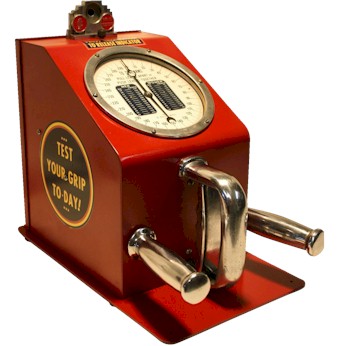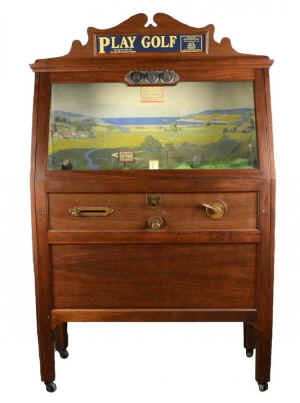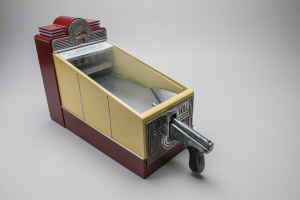|
A Penny for your Memories
By Nancy Wilson
Many years ago a young married couple, busy starting
out their life together, came across a chance to buy out a penny arcade.
The news of the sale came from one of their business partners who had
links to the islands of Lake Erie. The couple did not collect antiques,
but were intrigued by the thought of owning such a unique collection and
thought they might use the games in the nightclub they were operating.
And thus they planned a trip to Put-in-Bay OH on South Bass Island.
 The
establishment they visited was a combination gift shop and arcade,
Snowbird Gifts located right in the heart of downtown Put-in-Bay. The
games occupied a lot of space, and at the price of a penny, the games
didn’t bring in the revenue that the gifts did, so the owners wanted
to sell them. Today the couple still marvels at what they found there. The
establishment they visited was a combination gift shop and arcade,
Snowbird Gifts located right in the heart of downtown Put-in-Bay. The
games occupied a lot of space, and at the price of a penny, the games
didn’t bring in the revenue that the gifts did, so the owners wanted
to sell them. Today the couple still marvels at what they found there.
There were multiple countertop penny ‘personality
pieces’ by Exhibit Supply Company out of Chicago. Games such as Love
Meter, How Can I Find the Right Love Mate, Kiss-o-Meter, and Sex Appeal
Meter had a circle of lights behind painted glass. For a penny the
lights rotated around in a circle finally stopping on an answer, like
Passionate, Thrilling or Frigid.
A Grip Tester and Strength Tester did what their
names imply, registering on a spring-loaded indicator like a scale when
the customer squeezed a handle. Then the game ranked ranges of scores
into categories like Wimp or A Real He-Man. Customers had to be
convinced to drop their penny in the Electric Shocker. In order to
entice people to part with a penny, there were labels promoting the
health benefits of the ‘game,’ like improving circulation and
purifying the blood.
 Do
you remember those aluminum discs you used to be able to have made for
you at the state fair? You’d tell the merchant what you wanted
imprinted on them and he’d make a disc customized especially for you.
Most teenagers would choose ‘Suzie loves Bobby’ and the like. Then
you’d wear them around your neck on a chain. Well there at the arcade
was a floor model Metal Typer on which you could create your own disc.
Directions read "After inserting coin, turn pointer to letter
wanted, pull left handle once for each letter. When finished, pull right
handle to obtain medal." Do
you remember those aluminum discs you used to be able to have made for
you at the state fair? You’d tell the merchant what you wanted
imprinted on them and he’d make a disc customized especially for you.
Most teenagers would choose ‘Suzie loves Bobby’ and the like. Then
you’d wear them around your neck on a chain. Well there at the arcade
was a floor model Metal Typer on which you could create your own disc.
Directions read "After inserting coin, turn pointer to letter
wanted, pull left handle once for each letter. When finished, pull right
handle to obtain medal."
Target Skill was a countertop pistol shoot game where
the operator aimed at one of three holes at the back, like the one
pictured. A porcelain penny scale was also among the inventory. Not only
did you get your weight, but you got the benefit of a fortune too.
But the absolute cream-of-the-crop was two floor
model Chester-Pollard cabinet games. During the 1920s, the Chester
brothers, Frank, Charles, and Ernest (Pollard was their mother’s
maiden name.) sold & distributed sports and movie cards thru
coin-operated machines. They purchased the North American rights to
patents for the Play Football/Soccer game from a British manufacturer
and at first made 100 trial units, placing them at various locations
across the United States. The game was so successful the brothers
released more units the next year. We noted some discrepancy in the
dates of when these actions occurred – from 1924 to 1926.
 The
football game was obviously for two players and cost a nickel. Housed in
a wooden cabinet on legs were opposing teams of mannequins, dressed in
different colored cloth uniforms. For a nickel two players each operated
their own brass lever that made all the players on their team kick their
feet at the same time at a ball that came to rest in a slight depression
in the field in front of one of their players. If someone did score,
another nickel was required to get another ball. The game ended when a
‘team’ scored three points. The players kept score on a set of beads
strung on a wire over top of the cabinet window. The
football game was obviously for two players and cost a nickel. Housed in
a wooden cabinet on legs were opposing teams of mannequins, dressed in
different colored cloth uniforms. For a nickel two players each operated
their own brass lever that made all the players on their team kick their
feet at the same time at a ball that came to rest in a slight depression
in the field in front of one of their players. If someone did score,
another nickel was required to get another ball. The game ended when a
‘team’ scored three points. The players kept score on a set of beads
strung on a wire over top of the cabinet window.
The other Chester-Pollard cabinet housed the Play
Golf game, one player for a nickel, where a single golfer stood in the
left front corner of the unit. On the front side of the cabinet was a
slider that swiveled the golfer into position. The push of a lever made
him swing his club. There were three holes of varying difficulty at
which he could aim. It was definitely a game of skill.
After eight or ten years of use, the couple retired
the arcade games they had purchased, thinking that they would be
preserving them in some way by not allowing their customers to abuse the
games as they became increasingly valuable. After many years a
high-ticket-item picker/auctioneer came through town and purchased the
remaining arcade games the couple had stored and not yet sold, including
the two Chester-Pollard games.
Kind of wish we had them back now at American
Antiquities.
|